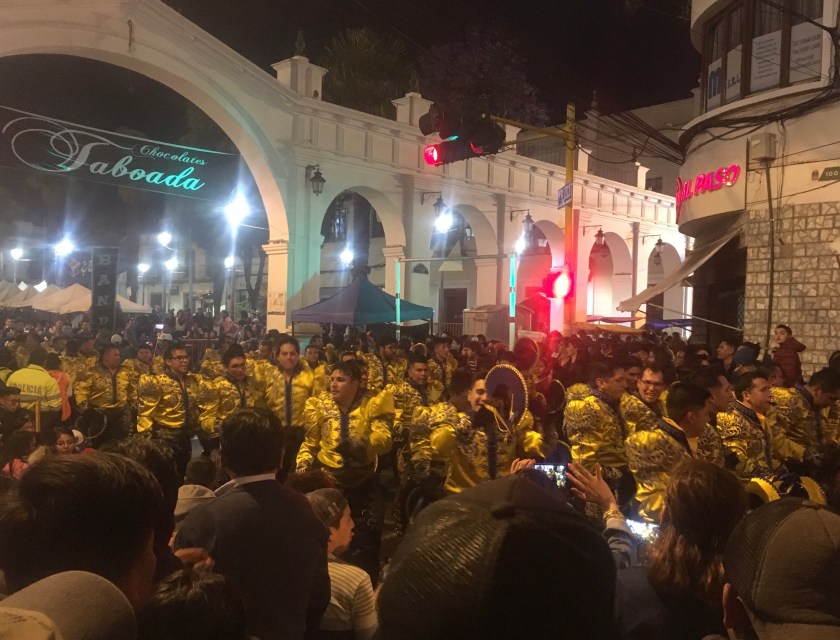Sucre is a colorful city, full of signs of its colonial history and teeming with life. A UNESCO World Heritage site, the capital of Bolivia, and the seat of the judicial power*, to me it felt strangely like a big city with a small town feel.
People from Sucre call themselves Chuquisaqueños because Sucre used to be called Chuquisaca and is the capital of the department Chuquisaca. During colonial times, the Spanish called the city “la plata” and it was the center of the region of Spanish rule called Los Charcas.
It bears the nickname “ciudad blanca” because of the traditional Spanish style white houses (not to be confused with Arequipa, Peru which has the same nickname but for the white stone of the region used in construction there.)

I only barely scratched the surface of this little gem (multiple other tourists had told me they had planned to stay only 2 days and had ended up staying a week or more), but I was just there a couple of days.
The best way to bring the city to life is to visit the “casa de la libertad” in the main plaza de armas, which is one of the best museums I’ve been to, and where you can see the original Declaration of Independence and get an excellent primer on the colonial history of the city…actually of all of Bolivia – and most of South America!

The guided tour of the museum explained the history of Spanish colonial rule, from the robbery of precious metals and the brutal treatment of the natives and African slaves, to the fight for freedom from Spanish rule – a history that is shared by the majority of South American countries, with heroes such as Sucre, Simon Bolivar, and Juana Azurduy.

Later I wandered into an art museum that gave a modern history lesson, told through alasitas – miniatures of everything. One day every year in Bolivia, vendors in the street sell everything in miniature, and this miniature version of things are called alasitas. I know, I didn’t get it either. But it’s a real thing. One day a year you can buy a doll-house sized version of just about every normal thing you might buy (toilet paper, detergent, clothes, everything!)

This little exhibit in the museum had collected alasitas throughout the years and told the history of the 70s, 80s, and 90s in Bolivia (mostly La Paz) through alasitas.

To my surprise, everyone I talked to told me I had to visit the cemetery. Finally, a French friend I made convinced me, and I have to say it was quite an experience. Not a Halloween-type experience. More like visiting a huge, beautiful, sacred park.

The entrance was as grand as the entrance to a palace, and it opened up to a huge manicured park with walkways lined with trees. It was so expansive it would have literally taken hours to walk all the different walkways to see all the different graves and mausoleums.

The walkways were lined with trees, and the air was filled with the sound of birds chirping on top of a very peaceful silence, the smell of flowers and cypress, and a mix of warmth from the sun and cool air in the shade. Workers were tending the grounds and planting flowers, and a few visitors were trending to their loved ones’ graves. At one point, in the distance I heard a woman sobbing loudly (wailing, really), and I felt the sadness of her loss, reminding me of the solemnity of the place.
The main walkway was lined with massive family mausoleums, and the other paths led to walls and walls of graves with locker-sized boxes decorated with memorabilia.

Interspersed were a few grave plots, and a few more large family mausoleums. There were large buildings dedicated to specific groups like rural teachers, union workers or people who had constructed certain roads.
The differences between the family mausoleums and the walls of hundreds of graves was both artistically interesting and also a distinct reminder of the huge class, power, and wealth divisions put in place by Spanish colonialism. (Not to say that previous societies didn’t have class divisions, just saying that in this particular place those divisions created by colonial rule are what are evident.)
I couldn’t have visited Sucre without some kind of outdoors adventure, so I went looking for the “7 cascadas” that the military guy in the taxi had told me about. It was an hour bus ride leaving the city, and from there I asked the locals to point me in the right direction. “It’s straight ahead, just follow the path”, they all said. And that’s when I realized I’m not as outdoors-expert as I thought I was, even after living in a rural place for three years, because I kept losing what they claimed was a clear path. Some young teenage girls trending a flock of sheep helped me find my way (after first laughing at me).
But I did eventually find all 7 of the waterfalls and was rewarded with a delightful swim in a pool beneath a waterfall.

On the way back (after getting lost one or twice), I ran into a group of Spanish, Germans, and Argentines also coming back from the falls, and we made our way back together, just catching the last bus back to the city and then exploring one of the markets together. This is why traveling alone never really feels like traveling alone.
Famous Footnotes
*La Paz holds the seat of the executive and legislative powers, which is why many call La Paz the capital, though Sucre is the constitutional capital of Bolivia
**The hostel I stayed in, Villa Oropeza, had a lovely garden area, good WiFi, and a super friendly staff, definitely one of my favorites so far!
























































































































